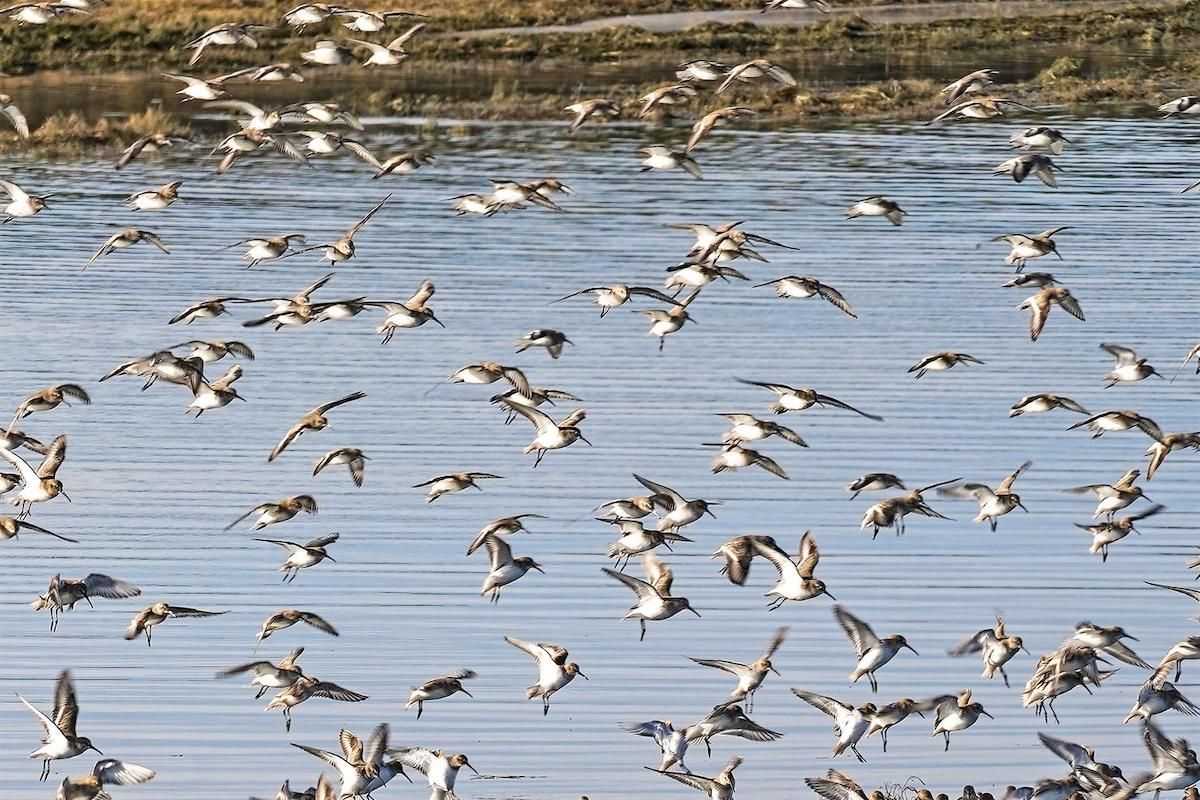The doctor told me when I was a child that I had a heart murmur. I had no idea what that meant, other than that it made a quiet whooshing sound along with the steady beating.
Murmurs are like spreading rumors or pleading prayers, done in whispers, except by lots of people at the same time. But not just people; animals spread rumors too, and not one by one but seven by seven, a thousand by a thousand. And not with a whisper, but with the beating of a wing or a fin, a change of direction in flight or fluid swimming.
- Check out this video of our walk. It’s just three minutes long.
We had a calm, sunny day this week, and Kath, Murphy, and I had to get outside to enjoy it. How about the Padilla Bay Shore Trail, Kath asked. Perfect, I said. The south parking lot had one spot left! We walked onto the trail, stretching our legs and lungs, looking around at the wide-open spaces of the diked wetlands, which were nearly full at high tide. Up ahead, we could see a harrier, cruising low and slow above the slough.
We couldn’t see the havoc this was causing among other birds, but we saw the evidence very soon.
Approaching that shoreside shed a quarter mile from the trailhead, we saw a joyous sight, for us humans, but a panicked response from the dunlins on the water. Hundreds of them were flying in the tightest formation you can imagine, going this way and that, above and along the slough, a hundred feet this way, a tight turn, a hundred feet that way, another turn, then settling down for a minute, then resuming the flight again, wingtip to wingtip, each bird changing direction in a choreographed aerial dance, flashing white bellies then dark backs, up the slough and down the slough, then back to another landing.
Pintail ducks had a ringside seat to it all as the dunlins looped overhead again and again, then settled back into the water alongside them, only to get up and do their next flying routine, in perfect synchronicity. This was a classic murmuration.
Why do they do that? It’s much harder for predators like the harrier to single out a particular bird in a flock when they’re all flying together. The more feathered friends in the flock, the lower the risk of being the one that gets snagged. Predators are more likely to catch the nearest prey, so the swirling of a murmuration happens as individual birds try to move toward the safer middle of the crowd. Scientists call this the selfish herd effect.
And a gigantic mass of whirling, swirling birds can make it hard for a predator to focus on a single target. A falcon or hawk can get confused and distracted by constantly changing wave patterns in the murmuration’s movements. It must also be careful not to collide with the flock and get hurt. And the more birds in a flock, the more eyes and ears to detect the predator before it’s too late.
Then there is that other question: How do they do that?
Researchers determined that starlings in large flocks consistently coordinate their movements with their seven nearest neighbors. When in flight, each flockmate matches its movements to the birds surrounding it. If one changes its flight direction or speed, the birds around do the same. This change spreads throughout the group, creating the patterns of the murmuration.
What physiological mechanisms allow it to happen almost simultaneously in two birds separated by hundreds of feet and hundreds of other birds? That remains to be discovered, and the implications extend beyond birds.
There is the mystery, the wonder, the heartbeat of life, waiting to be better understood. But for now, it’s an awe-inspiring sight.
On this day, the harrier had moved on, still hungry, as did we.
For a deeper dive
Here’s one of many scientific reports: https://journals.plos.org/ploscompbiol/article?id=10.1371/journal.pcbi.1002894
To watch a magical mysterious mesmerizing murmuration, here’s a video of thousands of starlings in England, who create a murmuration in the evenings. https://www.youtube.com/watch?v=V4f_1_r80RY
For schooling fish (and birds, too), consider this: The proximity of schooling reduces friction between each fish or bird. This means less effort for the fish to swim or the birds to fly, helping them conserve their energy.
